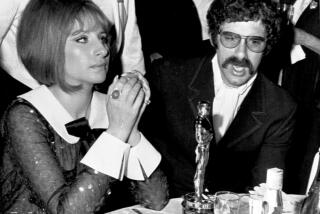Where All Roads Lead to Elvis
- Share via
Nothing more than a male burlesque dancer.
His performance was the most disgusting exhibition this reporter has ever seen.
The sound from the audience was like 12,000 girls having their heads shaved at once.
No matter how the teenagers howl, the boy is a show business freak. He’d better save his money while it’s pouring in [because the chances are] in a year or two no one will remember him.
*
Those comments from reporters in St. Paul, Minn.; Sioux City, Iowa; Seattle; and Miami, respectively, are typical of the media reaction to Elvis Presley across the country when he burst on the national scene in the mid-’50s.
Given Elvis’ legendary status now, it’s easy for generations of Americans who grew up after that initial rock explosion to assume that Presley’s talent was obvious from the moment “Heartbreak Hotel” first hit the airwaves.
In truth, Presley was such a revolutionary musical and cultural force that most of the adult world--including the media and the pop establishment--recoiled.
Although his early history has been touched on in countless books, Gray and Osborne make the story seem fresh and revealing in “The Elvis Atlas” by superimposing the information on a series of maps. Imagine a book on Elvis put together by the Thomas Brothers.
Through the various maps, we can walk three blocks with young Elvis from the family house on Old Saltillo Road in East Tupelo, Miss., to the Assembly of God Church on Adams Street, where he fell in love with gospel music, and on to the Tupelo Hardware Co. on Main Street, where Elvis’ mom bought him his first guitar.
Other maps enable the reader to follow Elvis to Memphis, Tenn., where he went to high school, and then to Beverly Hills and Palm Springs, which were his homes away from Graceland.
But the most revealing maps are tour itineraries. By the time RCA released “Heartbreak Hotel” in January 1956, he was an experienced performer, having done more than 150 shows, some in such odd locales as a high school chapel in Pine Bluff, Ark., and the courthouse meeting room in Corinth, Tenn.
The maps detailing his ‘70s tours are equally entertaining. Looking at the crisscrossing lines that trace his path, we understand what people close to him mean when they say that the only thing he enjoyed in his final years was being onstage. One map even details the canceled or “strange” concerts, mirroring the decline of Presley’s final years.
This is far from the complete Presley story, but “The Elvis Atlas” stands as a surprisingly touching and personal documentation of a man whose legend has become so large that it’s hard to identify with the person behind it.
*
* Items in this occasional column on books, videocassettes and laserdiscs are rated on a scale of one star (poor), two stars (fair), three stars (good) and four stars (excellent).
More to Read
The biggest entertainment stories
Get our big stories about Hollywood, film, television, music, arts, culture and more right in your inbox as soon as they publish.
You may occasionally receive promotional content from the Los Angeles Times.










